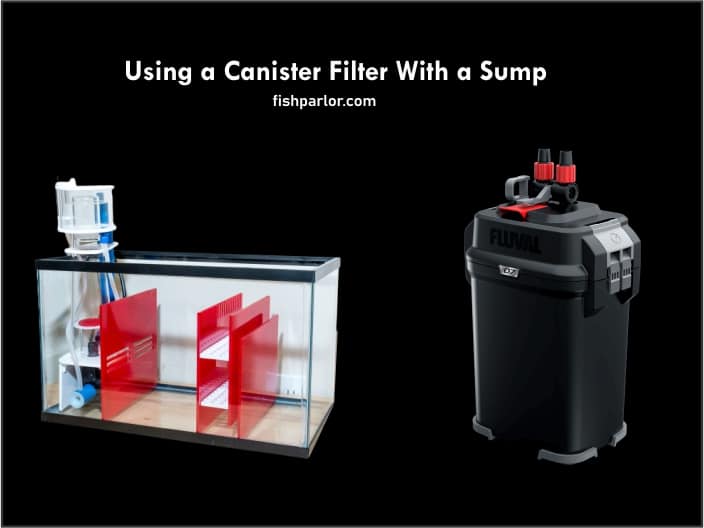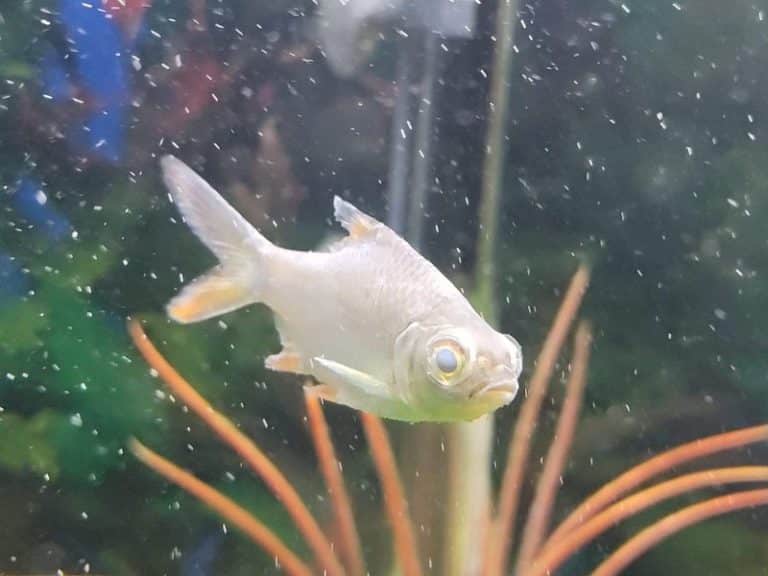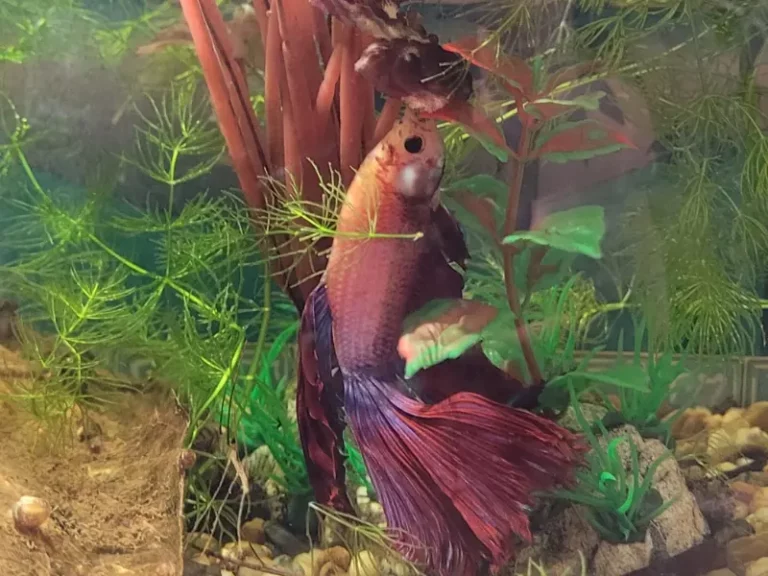While there is no harm in using a canister filter and a sump together, you need to know when to combine the two. In fact, using the two will boost water purification and aeration in an aquarium. However, you need to know when to use both of them.
One key aspect of both mechanisms is the way they work. A canister filter has a pre-installed filter and is perfect for cleaning the water in a tank. It sucks out the water with impurities, passes it through a filter, and pumps back the purified water into the tank.
On the other hand, a sump requires that you get a filter separately and install it. The sump relies on overflown surface water, which may be passed through a filter for cleaning before being pumped back into the tank. In some instances, such a setup may produce loud noises in the fish tank if not done correctly.

Does a sump need a filter?
A sump is a container where spilled water from the aquarium collects. The water is often pumped back into the aquarium. However, water pumped back into the aquarium might contain impurities. Therefore, using a filter with a sump keeps impurities from being pumped back into the aquarium.
Installing a filter with a sump for a sump is unnecessary if you feel that the canister filter purification system works perfectly. A sump can work independently without the canister filter if it has a sump filter fitted into the system.
Installing a filter and a sump to add an extra purification system for the water in an aquarium is advisable when there is a problem with air circulation and purification. The sump will be handy when your main interest is surface water purification.
It also helps prevent the formation of a film of dirt on the surface of the fish tank and mosquitoes since the latter hate moving water.
Can a canister filter and a sump work without each other?
A canister filter and a sump are independent of each other. A sump can work optimally without a filter, and the filter can also work without a sump. The difference lies in their capabilities.
The main differences between a canister filter and a sump filter are their positioning and functions. A canister filter is usually fitted outside the aquarium. It draws water from the main aquarium tank through a suction pipe. A sump is fitted beneath the aquarium and can only pump back spilled water. It does not draw water from the tank and has no filter.
| Canister filter | Sump pump |
| Easy to install as it has fewer parts | More parts hence more complex to install |
| Durable due to fewer parts: fewer failure points | Don’t last as long as canister filters |
| Powerful and can clean a tank several times over | Not as powerful as canister filters |
| Big filters are quite noisy | Discreet and compact |
| Higher initial cost than a sump pump | Relatively more affordable |
| Not very customizable due to fewer parts | Highly customizable |
| Thorough filtration thus suited to fresh water | Low filtration thus suited to salty water |
| Suited to tanks with few or no plants | Suited to planted tanks for surface cleaning |
| Doesn’t have extra storage. | Offers extra storage. |
| Can be used to culture bacteria. | Not used to culture bacteria. |
You may use a sump only for huge aquariums and not need to install a canister filter. In the same way, you may install a canister filter for a relatively small aquarium.
You may want to use both systems simultaneously for a medium-sized to a small aquarium. In such a case, a relatively small aquarium favors a canister filter as it supports a sump system. They purify water better than just one of them.
Some cases may require that you use the sump alone. For instance, if you have fingerlings, you may not want them sucked up by the canister filter. The sump may prove useful in preserving young fish in such a case.
Advantages of using a canister filter with a sump
Some of the advantages of using a canister filter with a sump are as follows:
| Advantages | Disadvantages |
| Provides additional water purification | Costly to install and maintain |
| Conducive for all fish sizes | It can be very noisy |
| Improves water aeration | Difficult to install |
| It provides optimal water movement | Very costly for saltwater aquariums |
- Using a canister filter with a sump implies additional purification for your aquarium. The spillover getting to your sump will undergo purification through the sump filter as it is pumped back into the tank. At the same time, the water in the tank will undergo purification through the canister filter.
- If used together, the two systems favor rearing all fish sizes. For instance, despite being an excellent inner tank cleaner, the canister filter may not be good for fingerlings in your aquarium. In such a case, the sump may do the job more effectively.
- Using a sump and the canister filter is good for surface and deep cleaning, improving water oxygenation. You will realize that a good purification system may reduce bubbler usage as the water readily combines with oxygen.
- Another key area you need to look at is water movement. A sump allows for better water movement, which is critical for the fish in the aquarium and yourself. For instance, you may not like to have bugs like mosquitoes breeding in your aquarium. Such bugs prefer breeding in stagnant waters. In that case, the water movement and the suction action of the canister filter will discourage bugs.
Disadvantages of using a filter with a sump
Some downsides to using a filter with a sump include the following:
- The primary disadvantage of using both systems at a time is the difficulty in installing them. You will need to spend more on buying and installing the two systems in a single aquarium.
- Similarly, you will have various challenges, especially regarding preferences.
- You will have to spend more on energy consumption and maintenance costs. Both systems require electricity to run their pumps, and the canister filter will need the power to suck water out of the tank and pump purified water back into the same tank.
- A saltwater setup for a canister filter is more demanding than a freshwater setup. Therefore, using both systems in a saltwater setup translates to added installations, making it more expensive to use both systems in such a situation.
- Noise is another challenge that usually accompanies canister filters. You may have realized that a sump can be less noisy than a canister filter. Imagine having two systems in one tank. You may not enjoy the quietness of a sump if you get irritated by noise easily.
Some fish, such as guppies, don’t need a filter to survive and will thus thrive with a sump pump alone. However, for the safety of your fish, always have a filter in place.
Advantages of a canister filter in an aquarium
Some of the advantages of using a filter in an aquarium include the following:
- A canister filter is available in various sizes, and the prices are likely to vary. It may be relatively cheaper to install a canister filter, purifying larger water volumes at any given time.
- The filter relies on its powerful water pumps to undertake its operations efficiently. Also, the pump can be kept away from the aquarium, and only the water pipes are channeled to and from the tank.
- Canister filters are also readily available as they are the most preferred by most aquarium owners in the United States.
- A canister filter also leaves the environment within which it operates dry and has lesser risks of spillages.
Filters are important and can help you get crystal clear water even in ponds.
Disadvantages of canister filters in an aquarium
The downsides of using a canister filter in your aquarium include the following:
- The primary disadvantage of the canister filter is that it produces noise in the aquarium. These filters generally let out a noise that may not favor fish that need quietness. In that regard, a canister filter may not be favorable for fixing in a room.
- Another primary challenge is the canister filter’s power to suck out water from the tank.
- A canister filter is also poor in surface cleaning. Therefore, installing a canister filter alone may leave your aquarium surface with impurities, especially if the impurities float on water.
- The powerful pump will likely suck out fingerlings, especially if the suction pipe is not fastened with a sponge.
- Finally, a canister filter pump requires more power to run. Thus, it consumes more electricity. It may not favor seamless operations as one may have reservations about energy consumption.
Even with these disadvantages, most aquariums and ponds can’t do without a filter.
Advantages of using a sump pump in an aquarium
Some of the advantages of using a sump pump include the following:
- The sump serves various purposes. This includes working as a storage compartment and trapping excess water from the aquarium.
- The sump may help in storing equipment and other decorative elements.
- Also, you may want to add more lighting to your aquarium, and the sump will come in handy. The reason is that a sump is usually designed under the aquarium.
- The sump also allows an aquarium owner to install an extra filter, adding more purification options to your aquarium.
- A sump will be perfect if you are interested in quietness, especially in your sleep. The sump relies on an extra filter that is often fitted separately and can be hidden far away from the tank.
- Because it relies on spillovers, a sump does not pose the risk of sucking out your fingerlings. This characteristic, coupled with the fact that it is perfect for surface cleaning, makes it quite ideal for an aquarium.
- The sump is the perfect choice if you are interested in energy saving. The system does not require suction pumps to draw water from the tank. It only needs the power to pump backwater into the aquarium.
Clearly, there are many benefits to using a sump pump in your aquarium.
Disadvantages of a sump pump in an aquarium
Some of the downsides of using a sump pump include the following:
- It may not favor the intense purification of an aquarium. It only works best with surface water.
- It is also relatively expensive to set up as it is also complicated. The sump may involve buying various components separately, making it rather tedious.
- Finally, if you want to purify your aquarium water, you may need an immersion system. The sump only relies on overflows, and there is no guarantee that impurities settled at the base of the aquarium will float to the top and undergo purification.
Most of these downsides can be done away with using a canister filter.
References:



